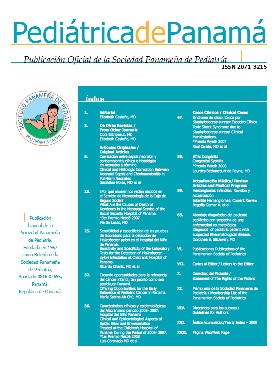Relationship of anemia and short stature with the diagnosis of Helicobacter pylori infection in children from 6 to 14 years old, from January 2014 to December 2016 at the Hospital del Niño Dr. José Renán Esquivel
1,
1,
1,
1,
1
Show Affiliation
Authors
DOI:
https://doi.org/10.37980/im.journal.rspp.20181617Keywords:
Helicobacter pylori, anemia, growth retardation, basic needs index, urease testAbstract
Introduction: Helicobacter pylori infection is the most widespread chronic bacterial disease in the world and affects more than half of the world population, with a distribution linked to the degree of economic development of each country. In the pediatric age there is no specific clinical picture of this infection. In children, it can have diverse clinical outcomes that include not only digestive symptoms but extra-digestive manifestations such as iron deficiency anemia and growth retardation. The relationship between Helicobacter pylori infection, iron deficiency anemia and short stature has been confirmed in multiple studies, but the issue remains controversial. Due to the scarcity of studies on this association, particularly in Panamanian children, and the impact of its short and long term complications on such a vulnerable population, it is of extraordinary importance to carry out studies to improve our understanding of this topic. Material and Methods: It is a retrospective, analytical, unmatched case and control study involving a total of 158 patients (79 cases and 79 controls) from the Hospital del Niño Dr. José Renán Esquivel, Panamá, between January 2014 to December 2016. Patient records were examined with autorization from the hospital’s bioethics committee. General demographic data and the selected study variables were obtained from patients who underwent upper digestive tract endoscopy with gastric biopsy that met the inclusion criteria. The existence of a statistical association was evaluated with Fishers exact test and odds ratio. Results: The average age of both groups was 9.75 + 2.75 with no statistical difference between the ages in the groups. Infection was more frequent in females (63%). Abdominal pain was the main indication for endoscopy. The frequency of anemia in the infected patients was 31%, higher than that reported in Latin American countries, but no association was found between anemia and Helicobacter pylori infection (p= 0.36), as there was no association with growth retardatin (p= 0.74). The socioeconomic level was lower in the sick patients (p= 0.01). The urease test showed 100% specificity. Conclusions: We did not find an association between anemia and short stature with Helicobacter pylori infection, but the frequency of anemia is high compared to other Latin American countries, and the socioeconomic level is an influential factor in the development of this infection. Longitudinal studies are needed that can evaluate patients in the evolution of the disease and determine the alterations in the hematological parameters and growth rate.Downloads
Published
2020-11-09
Issue
Section
Artículos originales
License
Copyright (c) 2020 Infomedic InternationalDerechos autoriales y de reproducibilidad. La Revista Pediátrica de Panamá es un ente académico, sin fines de lucro, que forma parte de la Sociedad Panameña de Pediatría. Sus publicaciones son de tipo gratuito, para uso individual y académico. El autor, al publicar en la Revista otorga sus derechos permanente para que su contenido sea editado por la Sociedad y distribuido Infomedic International bajo la Licencia de uso de distribución. Las polítcas de distribución dependerán del tipo de envío seleccionado por el autor.






